Biology 3B Laboratory Invertebrates II: Annelida, Nematoda, Arthropoda, Onychophora, Echinodermata Objectives
advertisement
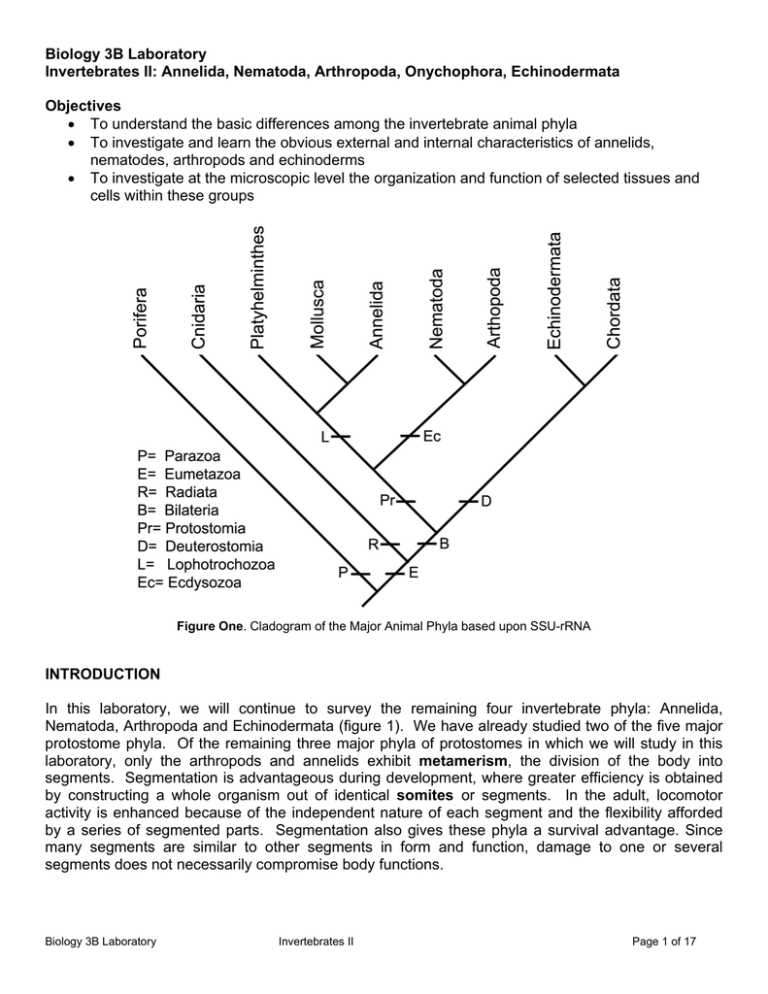
Biology 3B Laboratory Invertebrates II: Annelida, Nematoda, Arthropoda, Onychophora, Echinodermata Objectives • To understand the basic differences among the invertebrate animal phyla • To investigate and learn the obvious external and internal characteristics of annelids, nematodes, arthropods and echinoderms • To investigate at the microscopic level the organization and function of selected tissues and cells within these groups Figure One. Cladogram of the Major Animal Phyla based upon SSU-rRNA INTRODUCTION In this laboratory, we will continue to survey the remaining four invertebrate phyla: Annelida, Nematoda, Arthropoda and Echinodermata (figure 1). We have already studied two of the five major protostome phyla. Of the remaining three major phyla of protostomes in which we will study in this laboratory, only the arthropods and annelids exhibit metamerism, the division of the body into segments. Segmentation is advantageous during development, where greater efficiency is obtained by constructing a whole organism out of identical somites or segments. In the adult, locomotor activity is enhanced because of the independent nature of each segment and the flexibility afforded by a series of segmented parts. Segmentation also gives these phyla a survival advantage. Since many segments are similar to other segments in form and function, damage to one or several segments does not necessarily compromise body functions. Biology 3B Laboratory Invertebrates II Page 1 of 17 PHYLUM ANNELIDA Members in the phylum Annelida are often referred to as segmented worms because of their segmentation, a distinguishing characteristic that sets them apart form other animals. The most recognizable members include the earthworms (terrestrial habitat), leeches (terrestrial and freshwater), and marine worms. All annelids are triploblastic, bilaterally symmetrical, and eucoelomate. In addition, annelids exhibit a body wall with both longitudinal and circular muscle layers (which, along with segmentation mentioned above, allows these animals to be quite mobile). They have a complete digestive tract. Their nervous system shows some degree of cephalization with a “brain” and two ventral nerve cords that running the entire length of the body. They have a closed circulatory system with aortic arches that act as the “heart” to pump blood through muscular blood vessels. They also have a well developed excretory system which removes waste from the blood and coelom. There are three major classes within the phylum Annelida, described below. Class Polychaeta - mostly marine worms, such as Nereis (the clamworm) Class Hirudinea - the leeches (predominantly freshwater), such as Hirudo Class Oligochaeta - mostly freshwater and terrestrial worms, such as Lumbricus (the earthworms) OBSERVATION OF POLYCHAETA CLASS POLYCHAETA Polychaete worms are mostly a marine group of worms characterized by many segments with a pair of parapodia with numerous setae (figure 2). They have a distinct head with eyes, palps and tentacles. o Examine a clamworm (Nerius). These are the “typical” polychaete worms that can be found living in the mud and debris of shallow coastal waters. Using the dissecting scope, observe the head region and find the following: eyes, mouth on the ventral side, jaws, and tentacles. o Examine one of the segments. Locate a parapodium on one side a body segment. Parapodia function in locomotion and respiration for polychaetes. Each parapodium is comprised of two lobes which bear numerous setae (the reason for the class name). Figure 2: Structure of a clamworm (Nerius) OBSERVATION OF OLIGOCHAETA CLASS OLIGOCHAETA Like polychaete worms, oligochaete worms are also segmented both outside and inside. However, oligochaetes do not have parapodia, their head is less developed and they have fewer setae. The Biology 3B Laboratory Invertebrates II Page 2 of 17 most noticeable external feature in this group is the clitellum (figure 3). Most members in this class are either terrestrial (most) or inhabit freshwater. o Obtain an earthworm (Lumbricus) and place the animal in a dissecting tray. You may need a dissecting scope to fully appreciate the external anatomy. The first four segments comprise the head region. Find the mouth on the first segment (figure 3). The prostomium overhangs the mouth. They have a complete digestive tract that terminates on the last segment with the anus. o The most obvious external feature is the clitellum, a swollen area in the anterior third of the specimen. This region functions in reproduction by secreting a mucous which holds the participants together during sperm exchange and cocoon formation around the fertilized eggs. o Orient the worm dorso-ventrally by locating the tiny setae (hairs). Run your fingers along the animal to feel the rough texture produced by the setae. Four of these structures are found on the ventral surface of each metamere. They provide traction during locomotion. o Starting with the segment that holds the mouth, locate segment 14. Observe the openings for the oviducts (female pore) on the ventral surface. Find the sperm ducts (male pore) on the ventral surface of segment 15. Figure 3: Structure of an earthworm. We will examine the internal structure when we begin the systems. OBSERVATION OF HIRUDINEA CLASS HIRUDINEA The best known member in this class is the freshwater leech. Other members can be found on land and the marine environments. Members in this class typically have 33-34 segments with a clitellum. Most do not have setae and no members have parapodia. Members have both anterior and posterior suckers. o Examine representative members in this class. The medicinal leech, Hirudo medicinalis, secretes an anticoagulant on the host at they parasitized them. This leech was commonly used in the practice of blood-letting. It is still used today to increase circulation to surgical areas, especially with finger reattachments. Note the smaller oral sucker and larger posterior sucker. Biology 3B Laboratory Invertebrates II Page 3 of 17 PHYLUM NEMATODA Triploblastic pseudocoelomates The development of a body cavity (coelom) is considered a major evolutionary advantage over those animals which do not possess a body cavity (acoelomate). As you have already learned, body cavities are advantageous for a number of reasons, such as to provide more room for organ development, to provide an increased surface area for diffusion of gases and/or nutrients, and to facilitate locomotion by serving as hydrostatic skeleton. A body cavity is characteristic of all bilateral animals above the acoelomates. A true coelom is a cavity in which the inner body wall and the visceral organs are lined with peritoneum. A pseudocoeIom, found in animals to be examined in the present exercise, is defined as a body cavity that is lined by mesoderm externally and endoderm internally (figure 4). The nematodes are one of several phyla usually discussed together as the pseudocoelomates because of their shared possession of this structure. Except for this one common feature, they are a diverse group of animals, only distantly related. Included in this broad group of animals are the Phyla Rotifera, Nematomorpha, Gastrotricha, Kinorhyncha, and others. We will examine members of the phylum Nematoda as a representative pseudocoelomate. However, nematodes are grouped with arthropods as an ectodyzoan due to molecular evidence supporting ecdysis, the ability to shed the exoskeleton as the organism grows. Nematodes have a worldwide distribution that include, terrestrial, freshwater, marine and parasitic forms. They are round worms with a tough, flexible cuticle that is non;living. Nematodes are important ecologically for their recycling and decomposition capabilities. OBSERVATION OF NEMATODA • Examine the male and female intestinal roundworm, Ascaris lumbricoides, in dissecting tray. Gloves should be worn, if Figure 4: Comparison of body cavities. available. If not, handle organism with forceps. Do not touch with bare skin. Ascaris is sexually dimorphic and sexes are easily differentiated. Male worms are smaller, typically have a hook-shaped sideways bend near their posterior end, Biology 3B Laboratory Invertebrates II Page 4 of 17 and may have tiny copulatory spicules protruding slightly from the cloaca. Ascaris is an intestinal parasite of vertebrates, with A. lumbricoides infecting up to 64% of individuals living in the southeastern United States. The female lays up to 200,000 eggs/day which passes out of the host via their feces. The embryo is very resistant, thus be careful handling these worms as you could potentially infect yourself. o Examine the slide of a trichina worm, Trichinella spiralis. You will be observing calcified cyst of the juvenile trichina worm (figure 5) in the muscle of the host. Trichinosis is the disease that is caused by the trichina worm. Human infestations are typically due to the ingestion of undercooked meats such as pork. Roughly 2% of the population in the US has a light infection with trichina worms. Heavy infestations may cause death. Other species that can be infected include: hogs, rats, dogs, cats and any other omnivorous or carnivorous species. Figure 5: Encysted juvenile Trichinella spiralis o Examine the slide of a hookworm, Necator americanus. Note the anterior portion of the worm with a hook-like appearance in a tissue section. Infestations results when the juvenile hookworm comes in contact with the skin and burrows into the host. The juvenile then travels via the bloodstream to the lungs, move up the respiratory tract and then swallowed. In the small intestines they will mature. o Examine a slide of pinworms, Enterobius vermicularis. These worms live in the large intestines of humans and are the most common nematode parasite. These infestations are more embarrassing than debilitating. The female will travel to the anus at night to deposit eggs around the anus. Scratching contaminates the hands and bedding. The eggs are then swallowed and hatch in the duodenum and mature in the large intestines. This is a very common infestation in children. Biology 3B Laboratory Invertebrates II Page 5 of 17 o Examine the free-living nematode, the vinegar eel (Tubatrix aceti) on a depression slide, if available. These worms have a high tolerance to low pH. Describe how the body bends. PHYLUM ARTHROPODA The phylum Arthropoda is the largest in the animal kingdom. More than 75% of all living organisms are arthropods with insects contributing the greatest numbers. Like annelids they are characterized by metamerism, i.e. the body is segmented. In addition, they have a chitonous exoskeleton. The segmented body is divisible into functional units called tagmata. In some arthropods three tagmata are present - a head (involved in feeding and sensory functions), a thorax (involved mostly in locomotion), and an abdomen (which performs the visceral functions). In many arthropods the head and thorax are fused, forming a cepahalothorax. The phylum contains three extant subphyla - Chelicerata, Crustacea, and Uniramia. The subphylum Chelicerata contains arthropods in which the first appendages are modified into chelicerae (pincerlike feeding structures). Well-known representatives of this subphylum include the class Arachnida (scorpions, spiders, ticks, etc.) and the class Merostomata (horseshoe crabs). Major Arthropoda subdivisions (you are only responsible the taxonomy down to the class level) • • • • Subphylum Trilobita Subphylum Chelicerata o Class Merostomata - horsecrab o Class Pycnogonida – sea spiders o Class Arachnida • Order Araneae - spiders • Order Scorpionida - scorpions • Order Opiliones - harvestmen • Order Acari – ticks & mites Subphylum Crustacea o Class Branchiopoda • Order Cladocera – water fleas o Class Maxillopoda Subclass Copepoda - copepods Subclass Cirripedia - barnacles o Class Malacostraca • Order Isopoda – isopods, pill bugs • Order Euphausiacea - krill • Order Decapoda – crabs, shrimp, lobster, crayfish, etc. Subphylum Uniramia o Class Chilopoda - centipedes o Class Diplopoda - millipeds o Class Insecta - insects Biology 3B Laboratory Invertebrates II Page 6 of 17 OBSERVATION OF ARTHROPODA SUBPHYLUM TRILOBITA This extinct group has members dating back to the Carboniferous to the Cambrian. The body has two longitudinal furrows that run down the entire length. There is three distinct body sections: head, thorax, and abdomen. o Examine the fossil of a trilobite (Figure 6). Do not get it confuse with chitons. Figure 6. Trilobite SUBPHYLUM CHELICERATA Organisms that you will examine in this group includes: horseshoe crabs, spiders, ticks and scorpions. These organisms are grouped here because the first pair of appendages is modified into chelicerae for feeding. They also have a pair of pedipalps for capturing prey and four pairs of legs. There are two body segments: the cephalothorax and abdomen. • CLASS MEROSTOMATA This group contains the aquatic chelicerates such as the horseshoe crab and the extincit eurypterids. o Examine the horseshoe crab (Limulus). On the horseshoe shaped carapace comprises the cephalothorax, the simple eye and pair of compound eyes can be found on the dorsal surface. Behind the hinge is the abdomen. The telson is the tail. o Examine the ventral surface of Limulus (figure 7) Find the mouth. The chelicerae are the first pair of appendage used to manipulate food. The pedipalps are the second pair of appendages, used to capture prey. The remaining four pairs of appendages are the walking legs. On the abdomen, find the six leaf-like structures. The first is the genital opercula and the remaining five are the book gills (used for respiration). Figure 7: Dorsal and ventral view of Limulus Biology 3B Laboratory Invertebrates II Page 7 of 17 • CLASS ARACHNIDA This class consists of members that are rather familiar to most. They include spiders, scorpions, ticks and mites. All members posses a pair of cherlicera, pedipalps and four pairs of walking legs. o Examine the Cephalothorax of the garden spider Argiope (figure 8) Note the number of eyes. Identify the chelicerae. They have been modified into fangs for the injection of poison. Find the pedipalp. What’s its general function? In males, the pedipalps are modified as an intromittent organ to deliver sperm to the female. How many walking do spiders have and what body segment (tagmata) are they located? o Obtain a dissecting scope and examine the ventral abdominal region of Argiope. Look for the lung slit at the anterior portion of the abdomen. Towards the posterior end of the abdomen, you will notice three pairs of spinnerets on a raised surface responsible for silk production. Figure 8: Ventral view of Argiope o Examine a scorpion. The pincers are the pedipalps. Note the stinger with venom sac at the distal portion of the abdomen. o Examine the slide of a tick. These are ectoparasites on various vertebrates. Many can transmit diseases such as Lyme disease and Rocky Mountain spotted fever. o Examine the slide of a mite. Mites are some of the smallest archnids. Biology 3B Laboratory Invertebrates II Page 8 of 17 SUBPHYLUM CRUSTACEA In the subphylum Crustacea, mandibles are the primary feeding appendages. All crustacean appendages are biramous i.e. they have two processes extending from the base. Gills are used in respiration. Shrimp, crabs, lobsters, and many microscopic species are included in this subphylum. • CLASS MAXILLOPODA You will examine one group of organisms within this class, the barnacles. The body of the barnacle is sessile as an adult and is housed within a calcareous shell. We will have the opportunity to see living barnacles at the tidepools. When the tide is out (when we’ll be there); you will not be able to see the cirri (feeding legs). o Examine the shell of the acorn barnacle (Balanus). These are attached directly to the substrate. o Examine the gooseneck barnacle (Lepas – Figure 9). The main body is attached to the substrate via a stalk. Figure 9: Lepas • CLASS MALACOSTRACA We examine members in the order Decapoda only in this class. Decapods, as the name implies, have ten walking legs on the Cephalothorax which is covered by a hard carapace. Many have the first walking leg modified into a cheliped that is used in capturing prey and defense. o Examine the dorsal and ventral surface of a preserved crayfish (Cambarus – figure 10). Locate the following paired structures, then carefully remove them from one side and place them in the correct sequence on a sheet of paper (figure 11). Head ¾ Antennules – two, short filamentous structures at the tip of the rostrum for touch, taste and equilibrium ¾ Antennae – the long filamentous structure lateral to the antennules for touch and taste ¾ Mandible – bears teeth for crushing food Thorax ¾ First maxilla – for handling food ¾ Second maxilla – food handling and bailing water from gill chamber ¾ Maxilliped (1 – 3) – touch taste and food handling 2nd & 3rd maxilliped – have gills for respiration ¾ Cheliped (1st walking leg) – grasping food, defense and respiration ¾ Walking legs (2 – 4) – walking and respiration Abdomen ¾ Swimmerets – circulates water Males – 1st is modified to transfer sperm to female seminal receptacle Females – assists in carrying eggs and young (2 – 5) ¾ Uropod & Telson – locomotion & protecting eggs (female) Biology 3B Laboratory Invertebrates II Page 9 of 17 Figure 10 (above): Dorsal and ventral external crayfish structure Biology 3B Laboratory Invertebrates II Figure 11 (below): Crayfish appendages Page 10 of 17 o Examine other representative malacostracans (crabs, shrimp, etc.). We will examine the internal anatomy when we begin the systems. SUBPHYLUM UNIRAMIA Organisms in the subphylum Uniramia also have mandibles as the primary feeding appendages, however their appendages are uniramous (having only one process extending from the base), and a tracheal system is used for respiration. This large subphylum includes the following classes: lnsecta (Insects), Diplopoda (millipedes), and Chilopoda (centipedes). • CLASS CHILOPODA o Examine preserved centipedes. They do not have a hundred legs. They do have one pair of legs per body segment. The maxilliped is modified into a fang for the delivery of poison. Centipedes are active predators living in moist places. If live ones are available, observe their locomotion. • CLASS DIPLOPODA o Examine preserved millipedes. These do not have a thousand of legs. They do Figure 12: Centipede and millipede have two pairs of legs per body segment. Like centipedes, millipedes can be found living in moist habitats. However, they are herbivores or scavengers feeding on decaying wood or leaves. Some millipedes produce cyanide as a chemical defense mechanism. Observe the locomotion of live millipedes if available. • CLASS INSECTA This is by far the largest group of animals with estimates of over one million named species. The major characteristics of insects are: three walking legs on the thorax, one pair of antennae, three body segments (head, thorax and abdomen). Many insects have either one or two pairs of wings. • Examine a preserved grasshopper and observe its external features (figure 13). The exoskeleton is divided by sutures into plates called sclerites. o HEAD: The head consists of fused sclerites forming a cranium and mouth parts. A pair of antennae arise in front of the compound eyes. Three ocelli (simple eyes) can be seen one in the center, between the antennae, and two located above the base of the antennae. o THORAX: The thorax consists of three segments. The anterior prothorax bears the first pair of legs. The mesothorax (middle segment) bears a pair of legs and a pair of leathery wings. The metathorax (third segment) bears a pair of highly modified jumping legs and a Biology 3B Laboratory Invertebrates II Page 11 of 17 pair of membranous wings which are extension of the respiratory system. The legs are jointed. Examine the wings of a beetle (Orthoptera). The forewing is called the elytra which functions to protect the membranous hindwing that’s used for flight. Examine the wings of a cranefly (Diptera). The forewing is for flight and the hindwing is reduced and modified for balance. o ABDOMEN: The abdomen is simple, devoid of appendages, and made up of 10 to 11 segments. Note the terminal structures and use them to determine the sex of the specimen. Be sure to compare your grasshopper to one of the opposite sex. In the female, the ovipositor is for laying the eggs inside the earth. At the tip look for a pair of sensory structures known as cerci. Observe the female cricket and notice the long ovipositor for depositing eggs. o On either side of the first abdominal segment you might see a thin membrane, called the tympanum - a hearing organ. Spiracles are present on either side of most of the segments. The spiracles are most prominent in the thorax region. They are the breathing pores of the elaborate network of the tracheal system. Figure 13: External features of a female grasshopper. Insect have mouth parts that are adapted for the type of feeding they specialize in. There are four basic mouth parts: sucking mouthparts, sponging/lapping mouthparts, siphoning and chewing/biting mouthparts. You want to be able to differentiate these mouthparts for they type of feeding (figure 14). o o o o Examine the slide of the mosquito head (sucking mouthpart) Examine the slide of the butterfly head (siphoning mouthpart) Examine the slide of the fly head (lapping mouthpart) Examine the slide of the honeybee (chewing) Biology 3B Laboratory Invertebrates II Page 12 of 17 Chewing Sponging/Lapping Siphoning Sucking Figure 14: Insect mouthparts. PHLYUM ONYCHOPHORA Members in this group are often referred to as velvet or walking worms. They are an unusual group in that they have characteristics of annelids and arthropods. Onychophorans have changed very little in the past 500 million years. Aysheaia is a fossil onychophoran from the Burgess shale deposit that dates back to the mid-Cambrian. It looks very much like the modern day onychophorans. Some have called this the “missing link” between these two phyla. Onychophorans are a terrestrial species. They are active at night or when there is very high humidity. o Examine the preserved velvet worm (Peripatus). PHYLUM ECHINODERMATA Echinoderms are a group of animals that arose from bilaterally symmetrical ancestors even though the animals show pentaradial symmetry. Many of them have a bilateral larval stage and hence the radial feature may be secondarily acquired. As you have already studied, most radially symmetrical animals are sessile, however echinoderms are free moving. They are triploblastic and eucoelomate. Echinoderms are marine animals and that include: sea stars, sea urchins, sea cucumbers, and sea lilies. The body parts are arranged in "fives" around the oral/aboral axis. The most noticeable characteristics for echinoderms are the calcareous ossicles for the endoskeleton, the water vascular system with tube feet, pedicellariae, dermal branchiae and pentaradial symmetry. Major classes of Echinodermata include: Asteroidea – sea star Ophiuroidea - brittle stars, basket stars Echinoidea - sea urchins, sand dollars Holothuroidea - sea cucumbers Crinoidea - sea lilies, feather stars Biology 3B Laboratory Invertebrates II Page 13 of 17 OBSERVATION OF ECHINODERMATA CLASS ASTEROIDEA Sea stars are found in relatively shallow waters, and range in size from less than an inch to nearly three feet in diameter. They feed primarily on bivalves, prying the shell to open with their tube feet, everting their stomach into the victim's body cavity, and digesting it. The larvae are known as bipinnaria and have bilateral symmetry, whereas the adult form is star shaped with arms not sharply marked off from the central disk. Sea stars can perform autotomy (self-amputation) of their arms. However, if a small portion of the central disc remains attached to it, the amputated arm can then regenerate and form a new individual (a clone). o Examine live, preserved or dehydrated sea stars (figure 15). Identify the oral and aboral surfaces. Radiating from the central disk are the five arms, noting their spiny texture (from which they get the name echinoderm - spiny skin). At the tip of each arm is the eyespot. Note the calcareous spines, dermal branchiae (skin gills - little sac-like structures on the skin) and pedicellariae (claws - tiny pincer-like structures on some living sea stars that can aid in food capture or keep the sea star clean of debris). o The madreporite (a light colored, circular, slightly raised structure located on the aboral surface near the base of two arms) is the opening, or intake, of the water vascular system. The anus is seen as a minute opening at the center of the aboral surface. Ambulacral grooves are the deep grooves that extend from the oral surface along the midline of each arm. The tube feet are seen as double rows of soft tubular "feet" on each arm, lying along and just inside the ambulacral groove. On the dehydrated specimen, the tube feet may or may not be present. o Examine the living sea star, if available, observe the madreporite plate, eyespot, sensory tentacles (located at the tip of each arm/ray), ambulacral groove, tube feet and pedicellariae (if present). Figure 15: Dorsal and ventral sea star surfaces Biology 3B Laboratory Invertebrates II Page 14 of 17 CLASS OPHIUROIDEA Brittle stars are secretive echinoderms found from tidepools to great depths in the ocean. Although they are one of the more agile and abundant echinoderm, they are not frequently seen. On our tidepool trip, you will need to carefully turn over rocks to find brittle stars. If caught, brittle stars will often detach an arm (autotomize) in hopes that the predator is attracted to the wiggling arm as the brittle star escapes. Brittle stars differ from sea stars in that brittle star in that their ambulacral grooves are closed. Their tube feet are reduced and to do not have suckers. As a result, the tube feet are not used for locomotion. Instead, they “walk” with their arms. o Examine a preserved brittle (figure 16). Do not handle them roughly. On the oral surface find: mouth, five triangular jaws, oral shield located between the arms. Find the oral shield that’s modified into the madreporite plate. Note the spines on each arm. Figure 16: Oral view of the central disk of a brittle star. o Examine the preserved basket star. CLASS ECHINOIDEA This class includes sea urchins, heart urchins and sand dollars. This group is distinct in that they do not have arms and are more or less globular. They have tube feet with suckers and movable spines. Their ambulacral grooves are closed and covered by ossicles. o Examine the test of sea urchin. On the aboral surface, fine the madreporite plate, anus, ambulacral groove with tube feet pores, spine tubercle with or without the spine. On the oral surface, find the mouth and tooth. Biology 3B Laboratory Invertebrates II Page 15 of 17 Figure 17: External structure of the sea urchin o Examine the Aristotle’s lantern from the chewing complex of a sea urchin. o Examine a living sea urchin. Note the moveable spines and the tube feet. Do the tube feet have suckers? o Examine the sand dollar and heart urchin or sea biscuit on display. CLASS HOLOTHUROIDEA Sea cucumbers are placed into this class and have cucumber shape. There are no arms or spines. The ambulacral grooves are closed. Sea cucumbers have soft bodies because their ossicles are microscopic and embedded in the thick muscular wall. o Examine the sea cucumber (Cucumaria) and find the mouth at one end with the anus at the other. The mouth is surrounded by modified tube feet called tentacles. Biology 3B Laboratory Invertebrates II Page 16 of 17 CLASS CRINOIDEA Most crinoids (seas lilies and feather star) are an ancient group of enchinoderms with few living members. The oral end is “up” where as the aboral end has the attachment stalk or cirri. o Examine fossil or preserved specimens as available. Note the 10 arms with pinnules. The arms radiate from the calyx where the digestive and other organs are located. The calyx and arms are collectively called the crown. Biology 3B Laboratory Invertebrates II Page 17 of 17
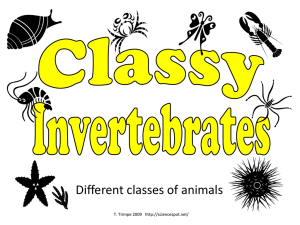
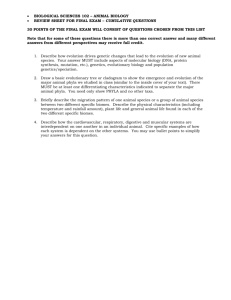
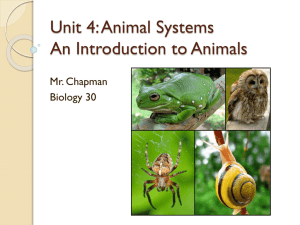
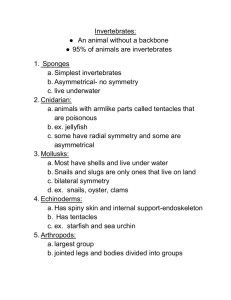
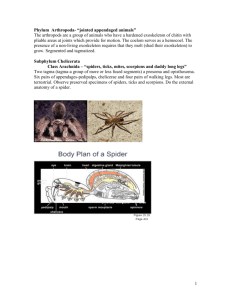
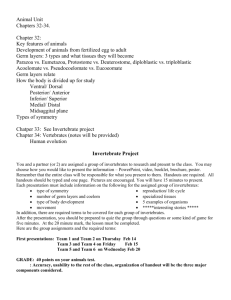
![MODULE8BIO113[1] (new window)](http://s3.studylib.net/store/data/009074544_1-97485b23d88e596afe61fa714cacfbd5-300x300.png)